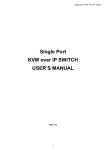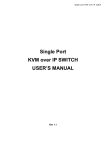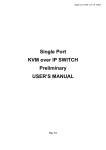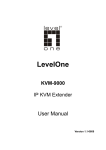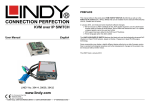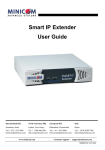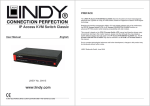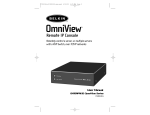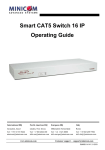Download Avocent PS/2 KVM User's Manual
Transcript
Single port PS2 KVM over IP Single Port PS/2 KVM over IP SWITCH Preliminary USER’S MANUAL Rev 1.0 Single port PS2 KVM over IP TABLE OF CONTENTS 1. THE QUICK INSTALLATION GUIDE 2. INTRODUCTION 2.1 When the sever is up and running 2.2 When the server is dead 2.3 FEATURES 2.4 PACKAGE CONTENTS 2.5 TECHNICAL SPECIFICATIONS 2.6 SYSTEM REQUIREMENT 2.7 CABLE DIAGRAMS PRODUCT DETAILS 3. HARDWARE INSTALLATION 3.1 Operation overview 3.2 Connecting PS/2 KVM over IP to the host system 4. CONFIGURATION 4.1 Initial configuration 4.1.1 Initial configuration via DHCP server 4.1.2 Initial configuration via local console 4.1.3 Mouse, Keyboard and Video configuration 4.1.3.1 PS/2 KVM over IP switch mouse settings 4.1.3.2 Host system mouse settings 4.1.3.3 PS/2 KVM over IP switch Video Modes 5. USAGE 5.1 Prerequisites 5.2 Login into PS/2 KVM over IP switch and logout 5.2.1 Login into PS/2 KVM over IP switch 5.2.2 Main screen 5.2.3 Logout from PS/2 KVM over IP switch 5.3 Remote console 5.3.1 Show remove console 5.3.2 Description of Remote Console Options 5.3.3 PS/2 KVM over IP switch mouse synchronization 5.3.3.1 Introduction 5.3.3.2 Auto mouse speed and mouse synchronization 5.3.3.3 Limitations of the mouse synchronization 5.3.3.4 Single and Double Mouse Mode 5.3.4 Video setting through the remote console 5.3.4.1 Video Settings through the HTML-Frontend 5.3.4.2 Video Settings through the remote console 5.4 PC settings 5.4.1 SSL settings 5.4.1.1 SSL certificate management 5.4.2 Mouse/keyboard setting 5.4.3 Video setting 5.4.4 User specific settings Single port PS2 KVM over IP 5.4.5 Remote console type 5.4.6 Mouse hotkey 5.4.7 Button keys 5.5 Network settings 5.5.1 Dynamic DNS 5.6 Serial settings 5.6.1 Modern setting 5.7 User settings 5.8 Maintenance 5.8.1 PS/2 KVM over IP switch board summary 5.8.2 Maintenance Features 5.8.2.1 Event log 5.8.2.1.1 Event log setting 5.8.2.1.2 Log event assignments 5.8.2.2 Date/Time setting 5.8.2.3 Update Firmware 5.8.3 Reset function 5.8.4 Reset PS/2 KVM over IP switch 5.9 Access via Telnet 6. TROUBLESHOOTING 7. PIN ASSIGMENTS 8. CERTIFICATES Single port PS2 KVM over IP 1. The Quick Installation Guide Installation PS/2 KVM over IP switch redirects local keyboard, mouse and video data to a remote administration console. All data is transmitted via IP. PS/2 KVM over IP switch can be used in a multi administrator and multi server environment as well. Besides this, PS/2 KVM over IP switch is a KVM switch, which can also be used with a local console. PS/2 KVM over IP hardware installation Host Console Figure 1.1 The connectors of single port PS/2 KVM over IP Front and rear side Please perform the following steps: 1. Connect the power supply on PS/2 KVM over IP switch 2. Connect the monitor to the PS/2 KVM over IP switch console side. 3. Connect the keyboard to the PS/2 KVM over IP switch console side. 4. Connect the mouse to the PS/2 KVM over IP switch console side. 5. Connect a VGA cable (15-pin HDDB Male / Male) with the Male side to both of the PC and the host port of the PS/2 KVM over IP switch. 6. Connect one purple end of 3-in-one cable to the PS/2 mouse port on the computer, and the other end of 3-in-one cable to the host PS/2 mouse port on the PS/2 KVM over IP Switch. 7. Connect one green end of 3-in-one cable to PS/2 keyboard port on the computer, and the other end of 3-in-one cable to the host PS/2 keyboard port on the PS/2 KVM over IP switch. 8. Connect Ethernet and/or modem, depending how you want to access PS/2 KVM over IP switch Video modes PS/2 KVM OVER IP recognizes a limited number of common video modes. When running X-Window on the host system, please don’t use any custom mode lines with special video modes. If done so, PS/2 KVM OVER IP may not be able to detect these. You are on the safe side with all standard VESA video modes. Please refer to Appendix A for a list of all known modes. Initial IP configuration Initially the PS/2 KVM over IP switch network interface is configured with the parameters shown in Table 1.1. Single port PS2 KVM over IP Parameter Value IP auto configuration DHCP — IP-Address Net-mask 255.255.255.0 Default-Gateway none IP access control disabled Table 1.1: Initial configuration If this initial configuration doesn’t meet your local requirements, you need to do the initial IP configuration. Use one of the following ways: 1. Connect the enclosed NULL modem cable to the serial interface on the rear side. The serial interface needs to be adjusted with the parameters shown in table 1.2: Parameter Value Bits/second 115200 Data bits 8 Parity No Stop bits 1 Flow Control None Table 1.2: Serial parameters Use a terminal software (e.g. hyper term or minicom) to connect to PS/2 KVM over IP switch. Reset PS/2 KVM over IP switch and immediately press < ESC >. You will see some device information and a ’=>’ prompt. Enter the command ’config’ and press < Enter >. After waiting a few moments you may configure IP auto configuration, IP address, net mask and default gateway. Pressing < Enter > without entering values does not change settings. The gateway value must be set to 0.0.0.0 (for no gateway) or any other value. You will be asked if the values are correct and get a chance to correct them. After confirming, PS/2 KVM over IP switch performs a reset. 2. Use an crossover Ethernet cable to connect PS/2 KVM over IP switch to a subnet where a DHCP server is available. After the DHCP server has assigned an IP address to PS/2 KVM over IP switch you can use the web interface to configure the device. Web interface PS/2 KVM over IP switch may be accessed using a standard web browser. You may use the HTTP protocol or a secure encrypted connection via HTTPS. Just enter the configured IP address of PS/2 KVM over IP switch into your web browser. Initially there is only one user configured who has unrestricted access to all PS/2 KVM over IP switch features: Login name Password Please login and change the password immediately according to your own policies. The Remote Console The Remote Console is the redirected screen, keyboard and mouse of the remote host system to which PS/2 KVM over IP switch is attached. The web browser which is used for accessing PS/2 KVM over IP switch has to supply a Java Runtime Environment version 1.1 or higher. The Single port PS2 KVM over IP Remote Console will behave exactly the same way as if you were sitting directly in front of the screen of your remote system. That means keyboard and mouse can be used in the usual way. Open the console by choosing the appropriate link in the navigation frame of the HTML fronted. Figure 1.2 shows the top of the Remote Console. Figure 1.2: Top part of the Remote Console There are some options to choose from, the important ones are the following: Auto Adjust button If the video displayed is of bad quality or distorted in some way, press this button and wait a few seconds while PS/2 KVM over IP switch tries to adjust itself for the best possible video quality. Sync Mouse Choose this option in order to synchronize the local with the remote mouse cursor. This is especially necessary when using accelerated mouse settings on the host system. In general there is no need to change mouse settings on the host. Video Settings in Options Menu This opens a new window with elements to control the PS/2 KVM over IP switch Video Settings. You can change some values, for instance related to brightness and contrast of the picture displayed, which may improve the video quality. It is also possible to revert to the default settings for all video modes or only the current one. Single port PS2 KVM over IP 2. Introduction Figure 2.1 Single port PS/2 KVM over IP Thank you for purchasing PS/2 KVM over IP switch. PS/2 KVM over IP switch can save your MONEY, TIME, SPACE, EQUIPMENT and POWER. PS/2 KVM over IP defines a new class of remote KVM access devices. PS/2 KVM OVER IP defines a new class of remote KVM access devices (see Figure 2.1). PS/2 KVM OVER IP combines digital remote KVM access via IP networks with comprehensive and integrated system management. PS/2 KVM over IP owes a convenient, remote KVM access and control via LAN or Internet. It captures, digitizes, and compresses video and transmits it with keyboard and mouse signals to and from a remote computer. PS/2 KVM over IP provides a non-intrusive solution for remote access and control. Remote access and control software runs on its embedded processors only but not on mission-critical servers, so that there is no interference with server operation or impact on network performance. Furthermore, PS/2 KVM over IP offers additional remote power management with the help of optional available device. PS/2 KVM over IP supports consoles consisting of PS/2 style keyboards, PS/2 style mouse and HDDB 15 video output. PS/2 KVM over IP will automatically detect the current video mode of the console, however manual fine tuning is recommended to receive the best video quality. PS/2 KVM over IP will accept video streams up to 110 MHz dot clock. This results in a screen resolution of 1280x1024 dots with a frame rate of 60 Hz. 2.1 When the server is up and running PS/2 KVM over IP switch gives you full control over the remote server. The Management Console allows you to access the remote server’s graphics, keyboard and mouse and to send special commands to the server. You can also perform periodic maintenance of the server. Using the Console Redirection Service, you are able to do the following: I. Reboot the system (a graceful shutdown). II. Watch the boot process. III. Boot the system from a separate partition to load the diagnostic environment. IV. Run special diagnostic programs. Single port PS2 KVM over IP 2.2 When the server is dead Obviously, fixing hardware defects is not possible using a remote management device. Nevertheless PS/2 KVM over IP gives the administrator valuable information about the type of a hardware failure. Serious hardware failures can be categorized into five different categories with different chances to happen: I. Hard disk failure 50% II. Power cable detached, power supply failure 28% III. CPU, Controller, main board failure 10% IV. CPU fan failure 8% V. RAM failure 4% Using PS/2 KVM over IP, administrators can determine which kind of serious hardware failure has occurred (See table 2.1). Type of failure Hard disk failure Power cable detached, power supply failure Detected by Console screen, CMOS set-up information Server remains in power on state after power on command has been given. CPU Controller, main board failure. Power supply is on, but there is no video output. CPU fan failure By server specific management software RAM failure Boot-Sequence on boot console Table 2.1:Host system failures and how they are detected. 2.3 Features Manage serves around the world KVM (keyboard, video, mouse) access over IP, ISDN or analogous telephone line. BIOS level access SSL encryption No impact on server or network performance Automatically senses video resolution for best possible screen capture High-performance mouse tracking and synchronization Port to connect a user console for direct analogous access to KVM switch Local Mouse suppression (only when using SUN’s Java Virtual Machine) Remote power management and remote system management Can be use with any standard KVM Low Density CAT5 cable to eliminate cable clutter at the rack Single port PS2 KVM over IP 2.4 Package contents Base unit- Single port PS/2 KVM over IP Switch 1 PCS User’s manual 1 PCS Installation and User Manual on CD-ROM 1 PCS AC to DC Power Adapter 1 PCS Rack Mount Kit 1 SET Null modem cable 1 PCS 2.5 Technical specifications Model No. PC Port Console Port PC Port Connector (All Female Type) Console Port Connector (All Female Type) Single port PS/2 KVM over IP Switch 1 1 PS/2 Keyboard Mini Din 6 pin PS/2 Mouse Mini Din 6 pin VGA HDDB 15 pin Local Console: PS/2 Keyboard Mini Din 6 pin PS/2 Mouse Mini Din 6 pin VGA HDDB 15pin Remote Console: RJ-45 8P8C 1 Serial Port(DB9 pin Male) LAN port(RJ-45 8P8C) 1 10BASE-T Ethernet uses Category 3/4/5/5E/6 UTP 100BASE-T Ethernet uses Category 5/5E/6 UTP Reset port 1 Keyboard Emulation PS/2 Mouse Emulation PS/2 VGA Resolution 1280 X1024 Bandwidth 200MHz Housing Metal Power Adapter DC 5V, 2.5A Operation Temperature 0~50℃ Storage Temperature -20 ~ 60℃ Humidity Size Weight (kg) Dimension (cm) 0~80%, Non-Condensing Desktop 1700g 156 X139 X27 Single port PS2 KVM over IP 2.6 System requirement Model No. Local console side Single port PS/2 KVM over IP Switch One Keyboard, one Mouse and one monitor Remote Console side One PC is linked into the network Computer side One PC or Server or the console port of KVM switch unit 2.7 Cable diagrams PS/2 Cable: Mini Din 6 pin Male to Male VGA Cable: HDB15 pin Male to Male AT to PS/2 keyboard adapter: (Optional) Din 5 pin Male to Mini Din 6 pin Female PS/2 to DB9 adapter (Optional) Mini Din 6 pin Female to DB 9 pin Female CAT5/5E/6 Straight Through UTP/STP Cable: 8P8C Single port PS2 KVM over IP 3. Hardware installation 3.1 Operation Overview Figure 3.1 shows the connections of PS/2 KVM over IP switch to its host, to peripheral devices, to the power source and to the local area network. Figure 3.1: PS/2 KVM over IP switch usage scenario PS/2 KVM over IP switch redirects local keyboard, mouse, and video data to a remote administration console. All data is transmitted via IP. PS/2 KVM OVER IP can be used in a multi administrator and multi server environment as well. Combining one or several PS/2 KVM OVER IPs with a KVM switched matrix allows to access multiple servers on a single remote console. 3.2 Connecting PS/2 KVM OVER IP to the host system or Multi-port KVM Switch system In order to connect the PS/2 KVM over IP switch of the host system perform the following steps: Step 1 Connect the power supply on PS/2 KVM over IP switch Step 2 Connect the monitor to the PS/2 KVM over IP switch console side. Single port PS2 KVM over IP Step 3 Connect the keyboard to the PS/2 KVM over IP switch console side. Step 4 Connect the mouse to the PS/2 KVM over IP switch console side. Step 5 Connect a VGA cable (15-pin HDDB Male / Male) with the Male side to both of the PC and the host of the PS/2 KVM over IP switch. Step 6 Connect one end to the PS/2 mouse port on the computer, and the other end to the host PS/2 mouse port on the PS/2 KVM over IP Switch. Step 7 Connect one end to PS/2 keyboard port on the computer, and the other end to the host PS/2 keyboard port on the PS/2 KVM over IP switch. Step 8 Connect Ethernet and/or modem, depending how you want to access PS/2 KVM over IP switch 3.2.1 Connecting the External Reset/Power Option Please refer to the manual of the PS/2 KVM over IP 8/16/32 port external power switch option or a third party external power option to connect those external devices to one of the serial interface on the rear side of PS/2 KVM OVER IP. By the date of printing this manual supported options are: Single port PS2 KVM over IP . Avocent.SPC1 800/1600 . Sentry In-Line Power Module . Leuning ePowerSwitch 3.2.2 Connecting Ethernet The rear side of PS/2 KVM over IP switch provides a RJ-45 connector for Ethernet. The connector is used either for a 100 Mbps 100BASE-TX connection or for a 10 Mbps 10BASE-T connection. The adapter can sense the connection speed and will adjust to the appropriate operation mode automatically. 3.2.2.1 10 Mbps Connection For 10BASE-T Ethernet networks, the Ethernet adapter uses Category 3, 4, or 5 UTP cable. To establish a 10 Mbps connection, the cable must be connected to a 10BASE-T hub. Make sure that the cable is wired appropriately for a standard 10BASE-T adapter. Align the RJ-45 plug with the notch on the adapter’s connector and insert it into the adapter’s connector. 3.2.2.2. 100 Mbps Connection For 100BASE-TX Fast Ethernet networks, PS/2 KVM over IP switch supports Category 5 UTP cabling. To establish a 100 Mbps connection, the cable must be connected to a 100BASE-TX hub. Make sure that the cable is wired appropriately for a standard 100BASE-TX adapter. Align the RJ-45 plug with the notch on the adapter’s connector and insert it into the adapter’s connector. 4. Configuration 4.1 Initial Configuration PS/2 KVM over IP switch’s communication interfaces are all based on TCP/IP. It comes pre-configured with the IP configuration listed in Table 4.1. Parameter Value IP auto configuration DHCP IP-Address — Net-mask 255.255.255.0 Default-Gateway none IP access control disabled LAN interface speed auto Auto LAN interface duplex mode Auto Table 4.1: Initial IP configuration In case this initial configuration doesn’t meet your requirements there is an initial IP configuration necessary in order to access PS/2 KVM over IP switch for the first time. This chapter describes different possibilities to accomplish that. 4.1.1 Initial configuration via DHCP server By default, PS/2 KVM over IP switch will try to contact a DHCP server in the subnet to which it is physically connected. If a DHCP server is found it may provide a valid IP address, gateway address and net mask. Before you connect the device to your local subnet be sure to complete the corresponding configuration of your DHCP server. It is recommended to configure a fixed IP assignment to the MAC address of PS/2 KVM over IP switch. You can find the MAC address on the outside of the shipping box and labeled on the bottom side. If the Single port PS2 KVM over IP DHCP connection fails on boot up, PS/2 KVM over IP switch will not have an IPv4 address. 4.1.2 Initial configuration via serial interface PS/2 KVM over IP switch has a serial line interface at its rear side. The connector is compliant to RS 232 serial line standard. The serial line has to be configured with the parameters given in Table 4.2. Parameter Value Bits/second 115200 Data bits 8 Parity No Stop bits 1 Flow Control None Table 4.2: Serial line parameters When using the configuration with a serial terminal, reset PS/2 KVM over IP switch and immediately press ESC. You will see some device information and a ’=>’ prompt. Enter ’config’, press < Enter > and wait a few seconds for the configuration questions to appear. As you go along you will see the following lines, which you have to answer or to which you may provide the default value by pressing < Enter >. The default value is shown in square brackets. IP auto configuration (none/dhcp/bootp) [dhcp]: IP [192.168.1.22]: NetMask [255.255.255.0]: Gateway (0.0.0.0 for none) [0.0.0.0]: . IP autoconfiguration With this option you can specify whether PS/2 KVM over IP switch should fetch its network settings from a DHCP or BOOTP server. For DHCP you have to enter DHCP and for BOOTP supply bootp accordingly. If you specify none then IP autoconfiguration is disabled and you will subsequently be asked for the following network settings. . IP address The IP address the PS/2 KVM over IP switch should use. This option is only available if IP autoconfiguration is disabled. . Subnet mask The mask of the connected IP subnet. This option is only available if IP autoconfiguration is disabled. . Gateway address The IP address of the default router of the connected IP subnet. If you have no default router, you may enter 0.0.0.0. This option is only available if IP autoconfiguration is disabled. There may be default values which are enclosed in brackets. If you want to use the default value of an option then you just need to press the Enter key. You will be asked if the values are correct and get a chance to correct them. After confirming, PS/2 KVM over IP switch performs a reset. 4.1.3 Mouse, Keyboard and Video configuration There are two interfaces between PS/2 KVM over IP switch and the host for transmitting keyboard and mouse data: USB and PS/2. The correct operation of the remote mouse depends on several settings which will be discussed in the following: 4.1.3.1 Host system mouse settings The host’s operating system also knows various settings for the mouse driver. While PS/2 KVM Single port PS2 KVM over IP over IP switch works with accelerated mice and is able to synchronize the local with the remote mouse pointer (see Section 5.3.3), there are the following limitations which may prevent this synchronization from working properly: Special Mouse Driver - There are mouse drivers, which influence the synchronization process leading to desynchronized mouse pointers. If this happens, make sure you don’t use a special vendor-specific mouse driver on your host system Windows XP Mouse - Setting Windows XP knows a setting to ’improve mouse acceleration’, which has to be deactivated 5. Usage 5.1 Prerequisites The PS/2 KVM OVER IP features an embedded operating system and the according applications offering a variety of standardized interfaces. The functionality is exposed to the user via these interfaces. This chapter will describe all of these interfaces and how to use them in detail. All the interfaces are accessed using the TCP/IP protocol family, thus they can be used equally over the built-in Ethernet adapter, over modem or over ISDN. The following interfaces are supported: 1. HTTP/HTTPS: The most complete access is provided by an embedded Web server. Thus the PS/2 KVM OVER IP environment can be entirely controlled by a standard Web browser. Depending on the Web browser you can access the PS/2 KVM OVER IP card using the unsecured HTTP protocol or, in case the browser supports it, the encrypted HTTPS protocol. It is recommended to use HTTPS whenever possible. 2. Telnet: A standard Telnet client can be used to access an arbitrary device connected to PS/2 KVM OVER IP’s serial port via a terminal mode. Since the primary interface of PS/2 KVM OVER IP is the HTTP interface this chapter is mainly concerning this topic. Other interfaces are explained in their according subtopics. In order to use the Remote Console window of your managed host system the browser has to come with a Java Runtime Environment version 1.1 or higher. But even if the used browser has no Java support, for instance on small handheld devices, you are still able to maintain your remote host system using the administration forms displayed by the browser itself. We recommend the following browser for an unsecured connection to PS/2 KVM OVER IP. Microsoft Internet Explorer version 5.0 or higher on Windows 98, Windows ME and Windows 2000, Windows XP Netscape Navigator 7.0 or Mozilla 1.0 on Windows 98, Windows ME, Windows 2000, Windows XP, Linux and other UNIX like Operating Systems In order to access the remote host system using a securely encrypted connection you need a browser that supports the HTTPS protocol. Strong security is only assured by using key length of 128 Bit. Many old browsers don’t have a strong 128 Bit encryption algorithm due to former export regulations of US authorities. For instance Internet Explorer 5.0, that comes as part of Windows ME and Windows 2000 supports a key length of 56 Bit only. You can read about the key length of your Internet Explorer under the menu points ‘?’ and ‘Info’. The dialog box shows also a hyperlink Single port PS2 KVM over IP that leads you to information on how to upgrade your browser to a state of the art encryption scheme. Figure 5.1 shows the dialog presented by Internet Explorer 6.0. However the US export regulations have been declared obsolete recently. Therefore, new browser versions do support strong encryption. We recommend the following browser for a secured connection to PS/2 KVM OVER IP. Microsoft Internet Explorer version 5.5 or higher on Windows 98, Windows ME and Windows 2000 and Windows XP Netscape Navigator 7.0 or Mozilla 1.0 on Windows 98, Windows ME, Windows 2000, Windows XP, Linux and other UNIX like Operating Systems Figure 5.1: Internet Explorer showing the encryption key length 5.2 Login into PS/2 KVM over IP switch and logout 5.2.1 Login into PS/2 KVM over IP switch Start your web browser and direct it to the address of your PS/2 KVM over IP switch that has been configured during installation. The address used might be a plain IP address or a host and domain name, in case you have given your PS/2 KVM over IP switch a symbolic name in the DNS. For instance, you have to type the following into the address line of your browser for establishing an unsecured connection: http://<IP address of PS/2 KVM over IP> or in case you like to use a secure connection: http://<IP address of PS/2 KVM over IP> This leads you to the PS/2 KVM over IP switch login page as shown in figure 5.2 Single port PS2 KVM over IP Figure 5.2 PS/2 KVM over IP switch login screen The PS/2 KVM over IP switch has a built-in super user that has all permissions to administrate your PS/2 KVM over IP switch: Login name Password Attention: Please make sure to change the super user password immediately after you have installed and firstly accessed your PS/2 KVM over IP switch. Not changing the super user password is a severe security risk and might result in unaut horized access to PS/2 KVM over IP switch and the host system with all possible consequences! Hints: The browser must be configured to accept cookies, otherwise login is not possible. The ‘super ’ can not be used to login via the serial interface of PS/2 KVM over IP switch. 5.2.2 Main Screen After a successful login, PS/2 KVM over IP switch will present its main screen consisting of three frames (see Figure 5.3) Single port PS2 KVM over IP Figure 5.3: PS/2 KVM over IP switch home menu window The upper left frame contains a home link that brings you instantly back to the home page after you stepped down to one of the administration menu points. The logout link logs you out of PS/2 KVM over IP switch. That means the current session will be terminated and you have to type username and password again to login. Note: The PS/2 KVM over IP switch will log you out automatically after there is no administration activity for half an hour. In this case each click on one of the links will lead you to the login screen where you have to provide the login information again. The lower left area of the PS/2 KVM over IP switch main window, called the menu frame, contains the main menu that leads you to the pages for various administration tasks. The functions of the menu frame will be described in detail during the following sections. The different function pages selected by one of the menu links will be presented in the big right frame, called the function area. Initially the function area contains three separate elements which are described in table 5.1. Feature Description Telnet Console This option offers a Java applet for the Telnet protocol to open a connection to PS/2 KVM over IP switch. Its main use is the passthrough option for the serial port 1. Of course it is also possible to connect with a standard Telnet client. For details regarding the Single port PS2 KVM over IP Telnet interface please refer to 5.9. Remove Console This picture contains the current video buffer content. That means, Preview it shows what is actually displayed on the desktop of the remote host. You can click on the picture to open the Remote Console. Server Power If serial port is set to IP-Power, the status of the power box is shown Status “On”. In this case, there is also a button to switch the state of the connected power box. The power state of the host can only be changed if the IP-Power power box is connected between the power supply and the power supply unit of the host system. When using the serial port for other purposes, the server power status is set to unavailable. Table 5.1: Meaning of the main menu PS/2 KVM over IP switch features 5.2.3 Logout from PS/2 KVM over IP switch This link logs out the current user and presents a new login screen. Please note that an automatic logout will be performed in case there is no activity for half an hour. 5.3 Remote Console 5.3.1 Show Remote Console The Remote Console is the redirected screen, keyboard and mouse of the remote host system PS/2 KVM over IP switch controls. Starting the Remote Console causes an additional window popping up that contains a copy of the screen of your host system (see Figure 5.4). The Remote Console will behave exactly in the same way as if you were sitting directly in front of the screen of your remote system. That means keyboard and mouse can be used in the usual way. However, be aware of the fact that the remote system will react to keyboard and mouse actions with a slight delay. The delay depends on the bandwidth of the line over which you are connected to PS/2 KVM over IP switch. Figure 5.4: Remote Console window showing a Windows 2000 desktop screen Single port PS2 KVM over IP With respect to the keyboard, the very exact remote representation might lead to some confusion as your local keyboard changes its keyboard layout according to the remote host system. For instance, special keys on the German keyboard won’t work anymore as expected but will result in their US English counterpart if you are using a German administration system but your host system uses a US English keyboard layout. You can circumvent such problems by adjusting the keyboard of your remote system to the same mapping as your local one. The Remote Console window is a Java Applet that tries to establish its own TCP connection to PS/2 KVM over IP switch. The protocol that is run over this connection is not HTTP or HTTPS but a protocol called RFB (Remote Frame Buffer Protocol). Currently RFB tries to establish a connection to port number 443. Your local network environment must allow this connection to be made, i.e. your firewall and, in case you have a private internal network, your NAT (Network Address Translation) settings must be configured accordingly. In case PS/2 KVM over IP switch is connected to your local network environment and your connection to the internet is available using a proxy server only without NAT being configured, the Remote Console is very unlikely to be able to establish the according connection. This is because today’s web proxies are not capable of relaying the RFB protocol. In case of problems, please consult your network administrator in order to provide an appropriate network environment. The Remote Console window always tries to show the remote screen with its optimal size. That means it will adapt its size to the size of the remote screen initially and after the screen resolution of the remote screen has been changed. However, you can always resize the Remote Console window in your local window system as usual. Hint: In difference to the remote host system, the Remote Console window on your local window system is just one window among others. In order to make keyboard and mouse work, your Remote Console window must have the local input focus. The upper part of the Remote Console window contains a control bar. Using its elements you can see the state of the Remote Console and influence the local Remote Console settings. Section 5.3.2 describes the meaning of each control. 5.3.2 Description of Remote Console Options Ctrl + Alt + Delete Special button key to send the ‘Control Alt Delete’ key combination to the remote system (see also Section 5.4.7 for defining new button keys). . State line Shows console and connection state. Normally it displays the size of the remote screen in pixels. The value in round brackets describes the connection to the remote system: Norm stands for a standard connection without encryption; SSL stands for a secured connection. In case there is a Single port PS2 KVM over IP connection error, it will be displayed in this line as well. You can double click the state line in order to see a history (see Figure 5.5) of all the state messages. Figure 5.5 Shows history of all the state messages . Auto adjust Starts the auto adjustment procedure to determine the settings for best visual quality of the grabbed image. This may take a few moments. During the process the display is turned off and you will see a notification message. . Sync mouse Activates the mouse synchronization process. Have a look at Section 5.3.3 for further information about this topic. . Single/Double mouse mode Switches between the Single Mouse Mode (where only the remote mouse pointer is visible) and the Double Mouse Mode (where remote and local mouse pointers are visible and need to be synchronized). Single mouse mode is only available if using SUN JVM 1.3 or higher. . Monitor Mode Toggles the read only mode on and off. In case the Monitor Mode check box is checked the Remote Console won’t accept any local input neither keyboard nor mouse. The symbol shows if the monitor mode is currently active or not. . Options --Scaling Allows you to scale down the Remote Console. You can still use mouse and keyboard, however the scaling algorithm won’t preserve all display details. . Options --Mouse handling The submenu for mouse handling offers two options for synchronizing the local and the remote mouse pointer, explained in Section 5.3.3. The option for ’Fast Sync’ shows the hotkey in parentheses in case you defined one using the Remote Console Settings. It is also possible to Single port PS2 KVM over IP activate the ’Exclusive Mouse Mode’ (see Section 5.3.5 for an explanation). . Options --Local Keyboard Used to change the language mapping of your browser machine running the Remote Console Applet. Normally the Applet determines the correct value automatically. However, depending on your particular JVM and your browser machine settings this is not always possible. A typical example is a German localized system that uses an US-English keyboard mapping. In this case you have to change the Local Keyboard setting manually to the right language . Options --Video Settings Opens a panel for changing the PS/2 KVM over IP switch video settings. Have a look at Section 5.4.3 for a detailed description of the available options. . Options --Local cursor Offers a list of different cursor shapes to choose from for the local mouse pointer. The selected shape will be saved for the current user and activated again next time this user opens the Remote Console. The number of available shapes depends on the Java Virtual Machine, only a version of 1.2 or higher offers the full list. The Remote Console title bar shows some information about the incoming (’In:’) and outgoing network traffic (’Out:’). 5.3.3 PS/2 KVM over IP switch Mouse Synchronization 5.3.3.1 Introduction A common problem with KVM devices is the synchronization between the local and remote mouse cursors. PS/2 KVM over IP switch addresses this situation with an intelligent synchronization algorithm. There are two mouse modes available on PS/2 KVM over IP switch. . Auto mouse speed - The automatic mouse speed mode tries to detect the speed and acceleration settings of the host system automatically. See the section below for a more detailed explanation. . Fixed mouse speed - This mode just translates the mouse movements from the Remote Console in a way that one pixel move will lead to n pixel moves on the remote system. This parameter n is adjustable with the scaling. It should be noted that this works only when mouse acceleration is turned off on the remote system. 5.3.3.2 Auto mouse speed and mouse synchronization The automatic mode performs the speed detection during mouse synchronization. Whenever the mouse doesn’t move correctly, there are two ways for re-synchronizing local and remote mouse: Fast Sync - The fast synchronization is used to correct a temporary, but fixed skew. Choose the option using the Remote Console options menu (see Section 5.3) or press the mouse synchronization hotkey sequence in case you defined one (refer to Section 5.4). Single port PS2 KVM over IP Intelligent Sync - If the fast sync doesn’t work or the mouse settings have been changed on the host system, use the intelligent resynchronization. This method takes more time than the fast one and can be accessed with the appropriate item in the Remote Console option menu. The intelligent synchronization requires a correctly adjusted picture. Use the auto adjustment function or the manual correction in the Video Settings panel (refer to Section 5.4.3) to setup the picture. The ’Sync mouse’ button on top of the Remote Console can behave differently, depending on the current state of mouse synchronization. Usually pressing this button leads to a fast sync, except in situations where the KVM port or the video mode changed recently. 5.3.3.3 Limitations of the mouse synchronization While the intelligent algorithm works fine for common cases, there are some special limitations which may prevent the synchronization from working properly: Special Mouse Driver - There are mouse drivers, which influence the synchronization process leading to desynchronized mouse pointers. If this happens, make sure you don’t use a special vendor-specific mouse driver on your host system Windows XP Mouse Setting - Windows XP knows a setting to ’improve mouse acceleration’, which has to be deactivated Badly adjusted picture - To have the intelligent sync working, a correctly adjusted picture is necessary. Use the auto adjustment function or the manual correction in the Video Settings panel (refer to Section 5.4.3) to setup the picture. The video also has to be of sufficiently good quality. Active Desktop - Check if you have the Active Desktop feature of Microsoft Windows enabled. If so, don’t use a plain background, use some kind of wallpaper. You could also disable the Active Desktop entirely. 5.3.3.4 Single and Double Mouse Mode The information above applies to the Double Mouse Mode, where remote and local mouse pointers are visible and need to by synchronized. PS/2 KVM over IP switch also features another mode, the Single Mouse Mode, where only the remote mouse pointer is visible. Activate this mode in the open Remote Console (see Section 5.3) and click into the window area. The local mouse pointer will be hidden and the remote one can be controlled directly. To leave this mode, it is necessary to define a mouse hotkey in the Remote Console Settings Panel (Section 5.4). Press this key to free the captured local mouse pointer. Single Mouse mode needs at least a Sun Java Virtual Machine 1.3 5.3.4 Video settings PS/2 KVM over IP switch features two different dialogs which influence the video settings. 5.3.4.1 Video Settings through the HTML-Frontend In Remote Console Settings is the video options panel of the PS/2 KVM over IP switch HTML-Frontend. For a detailed description of PS/2 KVM over IP switch Video Settings please refer to Section 5.4.3. Single port PS2 KVM over IP 5.3.4.2 Video Settings through the remote console PS/2 KVM over IP switch features a panel to setup the following video options (see Figure 5.6), available in the Remote Console Options menu. Figure 5.6: Video Settings Panel Brightness Contrast Clock Controls the brightness of the picture Controls the contrast of the picture Defines the horizontal frequency for a video line and depends on the video mode. Different video card types may require different values here. The default settings in conjunction with the auto adjustment procedure should be adequate for all common configurations. If the picture quality is still bad after auto adjustment you may try to change this setting together with the sampling phase to achieve a better quality. Phase Defines the phase for video sampling, used to control the display quality together with the setting for sampling clock. Phase Defines the phase for video sampling, used to control the display quality together with the setting for sampling clock. Horizontal Position Use the left and right buttons to move the picture in horizontal direction while this option is selected Vertical Position Use the left and right buttons to move the picture in vertical direction while this option is selected Reset this Mode Resets mode specific settings to their factory defaults Reset all Modes Resets all settings to their factory defaults Save changes Save changes permanently Undo changes Restore last settings Brightness, Black level and Contrast affect all modes and KVM ports globally; the other settings are changed specifically for each mode on each KVM port. 5.4 PC Setting The PC settings allow you to customize the Remote Console window prior to its start (see Figure 5.7). Some of the parameters you might still change while the Remote Console is running while others have to be set in the Remote Console settings. Single port PS2 KVM over IP Figure 5.7: Example of Remote Console settings All the settings for the Remote Console window are user specific. That means, each user can individually customize the Remote Console for his needs. Changing the settings for one user does not affect the settings for others. 5.4.1 SSL Settings Table 5.3 explains the possible adjustments related to the usage of SSL. Single port PS2 KVM over IP Figure 5.8: Security settings Parameter Force HTTPS KVM encryption Description If this option is enabled access to the web front-end is only possible using an HTTPS connection. PS/2 KVM over IP switch won’t listen on the HTTP port for incoming connections. In case you want to create your own SSL certificate that is used to identify this PS/2 KVM over IP switch refer to Section 5.4.1.1. This option controls the encryption of the RFB protocol, the protocol used by the Remote Console to transmit the screen data to the administrator machine and keyboard and mouse data back to the host. If set to ‘Off’ no encryption will be used. If set to ‘Try’ the applet tries to make an encrypted connection. In case connection establishment fails for any reason an unencrypted connection will be used. If set to ‘Force’ the applet tries to make an encrypted connection. An error will be reported in case connection establishment fails. Table 5.3: Security parameters 5.4.1.1 SSL Certificate Management PS/2 KVM over IP switch uses the SSL protocol for any encrypted network traffic between itself and a connected client. During connection establishment, PS/2 KVM over IP switch has to expose its identity to a client using a cryptographic certificate. Upon delivery, this certificate is the same for all PS/2 KVM over IP switches ever produced and certainly won’t match the network configurations that will be applied to the devices by its user. The certificate’s underlying secrete (private) key is also used for securing the SSL handshake. Hence, this is a security risk (but far better than no encryption at all). However, it is possible to generate and install a new certificate that is unique for a particular device. In order to do that, PS/2 KVM over IP switch is able to generate a new cryptographic key and the associated so called Certificate Signing Request that needs to be certified by a so called certification authority (CA). A certification authority verifies that you are who you claim you are and signs and issues a SSL certificate to you. The following steps are necessary to create and install a PS/2 KVM over IP switch SSL certificate: 1. Create a SSL Certificate Signing Request using the panel shown in Figure 5.9 (Security Settings -> SSL Settings -> Create your own SSL certificate). You need to fill out a number of fields that are explained above. Once this is done, click ‘Create CSR’ which will initiate the Single port PS2 KVM over IP Certificate Signing Request generation. The CSR can be downloaded to your administration machine with the ‘Download CSR’ button (see Figure 5.10). 2. Send the saved CSR to a CA for certification. You will get the new certificate from the CA after a more or less complicated traditional authentication process (depending on the CA). 3. Upload the certificate to PS/2 KVM over IP switch using the ‘Upload’ panel as shown in Figure 5.10. After completing these three steps, PS/2 KVM over IP switch has its own certificate that is used for identifying the device to its clients. . Important Note: If you destroy the CSR on PS/2 KVM over IP switch there is no way to get it back! In case you deleted it by mistake, you have to repeat the three steps In the following the various options of the dialogs are described, Figure 5.9: SSL Certificate Request . Common name This is the network name of PS/2 KVM over IP switch once it is installed in the user’s network (usually the fully qualified domain name). It is identical to the name that is used to access the device with a web browser (without the ‘http://’ prefix). In case the name given here and the actual network name differ, the browser will pop up a security warning when the device is accessed over HTTPS. . Organizational unit This field is used for specifying to which department within an organization PS/2 KVM over IP switch belongs. . Organization The name of the organization to which PS/2 KVM over IP switch belongs. . Locality/City Single port PS2 KVM over IP The city where the organization is located. . State/Province The state or province where the organization is located. . Country The country where the organization is located. This is the two-letter ISO code, e.g. DE for Germany or US for the USA. . Challenge Password Some certification authorities require a challenge password to authorize later changes on the certificate (e.g. revocation of the certificate). The minimal length of this password is 4 characters. . Confirm Challenge Password Confirmation of the Challenge Password . Email The email address of a security contact person that is responsible for PS/2 KVM over IP switch. . Key length This is the length of the generated key in bits. 1024 Bits are supposed be sufficient for most cases. Larger keys may result in slower response time of PS/2 KVM over IP switch during connection establishment. Figure 5.10: SSL Certificate Signing Request 5.4.2 Mouse / Keyboard Settings Host Interface This option allows to configure, which host interface is used. If these options are set to “Auto”, PS/2 KVM over IP switch detects, which interface is connected and used by the host. If USB and PS/2 are both connected then the card will prefer USB if available or otherwise falls back to PS/2. To prevent the automatic detection, you can also select “USB” or “PS/2” manually. Depended Single port PS2 KVM over IP on the Host interface setting, not all of the following options are always visible. Warning: To get USB remote keyboard access during the boot process of the host, the following conditions must be fulfilled: – the host’s bios must have USB keyboard support – the USB cable must be connected – “USB” or “Auto” must be selected in the Host interface option . USB Mouse Type Selecting “MS Windows 2000 or newer” enables the “absolute” mouse mode. In this mode the remote mouse is always synchron with the local mouse. It is encouraged to select this, if you have an appropriate operating system on the host. Otherwise select “Other Operating System”. . Mouse Mode —Auto mouse speed Use this option if the mouse settings on host use an additional acceleration setting. LARA eco tries to detect the acceleration and speed of the mouse during the mouse sync process. . Mouse Mode —Fixed mouse speed Use a direct translation of mouse movements between the local and the remote pointer. You may also set a fixed Scaling which determines the amount the remote mouse pointer moved when the local mouse pointer is moved by one pixel. This option only works when the mouse settings on host are linear, means that there is no mouse acceleration involved. 5.4.3 Video Settings Figure5.11: Video Settings in HTML front-end Enable local video port This option decides if the local video output of PS/2 KVM over IP switch is active and passing through the incoming signal from the host system. Noise filter This option defines how PS/2 KVM over IP switch reacts to small changes in the video input signal. A large filter setting needs less network traffic and leads to a faster video display, but small changes in some display regions may not be recognized immediately. A small filter displays all changes instantly but may lead to a constant amount of network traffic even if display content is not really changing (depending on the quality of the video input signal). All in all the default setting should be suitable for most situations. Single port PS2 KVM over IP Video quality and speed Using this option it is possible to tune the video system of PS/2 KVM over IP switch to either maximize picture quality or speed. When set to "best quality" the picture looks clean but the video update speed won’t be as fast as possible. If responsiveness is more important to you than achieving the best quality, set the option to ’high speed’. In this mode, artifacts will appear. Please note, that the difference is only clearly visible when using fast network links and the normal compression for the Remote Console. This option is not available on all hardware versions of PS/2 KVM over IP switch 5.4.4 User Specific Settings The following settings are user specific. That means, the super user can customize these Settings for every users separately. Changing the settings for one user does not affect the settings for others. . User select box This control will show the user ID for which the values are shown and for which changes will take effect. You might change the settings of other users in case you have the necessary access rights. 5.4.5 Remote Console Type Specifies, which Remote Console Viewer use. – Default Java-VM Use the default Java Virtual Machine of your Browser. This may be the Microsoft JVM for the Internet Explorer or the Sun JVM if it is configured this way. Use of the Sun JVM may also be forced (see below). – Sun Microsystems Java Browser Plug-in Instructs the web browser of your administration system to use the JVM (Java Virtual Machine) of Sun Microsystems. The JVM in the browser is used to run the code for the Remote Console window, which is actually a Java Applet. If you check this box for the first time on your administration system and the appropriate Java plug-in is not already installed on your system, it will be downloaded and installed automatically. However, in order to make the installation possible, you still need to answer the according dialogs with YES. The download volume is around 11 Mbytes. The advantage of downloading Sun’s JVM lays in providing a stable and identical Java Virtual Machine across different platforms. The Remote Console software is optimized for this JVM versions and offers wider range of functionality when run in SUN’s JVM. (Hint: If you are connected over a slow connection to the Internet you can also pre-install the JVM on your administration machine. The software is available on the CD that is delivered along with PS/2 KVM over IP switch.) 5.4.6 Mouse hotkey Allows to specify a hotkey combination which starts either the mouse synchronization process if pressed in the Remote Console (see Section 5.4.2 for more information) or is used to leave the single mouse mode. The key codes are listed in Appendix B. 5.4.7 Button Keys Button Keys are meant for simulating keystrokes on the remote system that cannot be generated locally. The reason for this might be a missing key or the fact, that the local operating system of the Remote Console is unconditionally catching this keystroke already. Typical examples are ‘Control Alt Delete’ on Windows and DOS, what is always caught or ‘Control Backspace’ on Single port PS2 KVM over IP Linux for terminating the X-Server. The syntax to define a new Button Key is as follows: [confirm] < keycode > [+| - [_] < keycode >]_ confirm requests confirmation by a dialog box before the key strokes will be sent. keycode is the key to be sent. Multiple key codes can be concatenated with a + or a - sign. The + sign builds key combinations, all keys will be pressed until a - sign or the end of the combination is encountered. In this case all pressed keys will be released in reversed sequence. So the - sign builds single, separate keypresses and -releases. The * inserts a pause with a user-definable duration. For a list of key codes and aliases PS/2 KVM over IP switch recognizes refer to Appendix B. Pressing the Apply button finally changes the values permanently in PS/2 KVM over IP switch. 5.5 Network Settings The Network Settings panel as shown in Figure 5.12 allows changing network related parameters. Each parameter will be explained below. Once applied the new network settings will immediately come into effect. Note: The initial IP configuration is usually done directly at the host system using the special procedure described in Section 4.1. However you can also connect to the PS/2 KVM over IP switch using its pre-configured IP settings. Attention: Changing the network settings of PS/2 KVM over IP switch might result in losing connection to it. In case you change the settings remotely make sure all the values are correct and you still have an option to access the PS/2 KVM over IP switch. Single port PS2 KVM over IP Figure 5.12: PS/2 KVM over IP switch network settings . IP auto configuration With this option you can control if PS/2 KVM over IP switch should fetch its network settings from a DHCP or BOOTP server. For DHCP you have to enter dhcp and for BOOTP supply bootp accordingly. If you specify none then IP autoconfiguration is disabled. . IP address IP address in the usual dot notation. . Subnet mask The net mask of the local network. . Gateway IP address In case the PS/2 KVM over IP switch should be accessible from networks other than the local one, this IP address must be set to the local network router’s IP address. . Primary DNS Server IP address IP address of the primary Domain Name Server in dot notation. This option may be left empty; however PS/2 KVM over IP switch won’t be able to perform name resolution. . Secondary DNS Server IP address IP address of the secondary Domain Name Server in dot notation. It will be used in case the Primary DNS Server can’t be contacted. . Remote Console & HTTPS port Single port PS2 KVM over IP Port number at which PS/2 KVM over IP switch’s Remote Console server and HTTPS server are listening. If left empty the default value will be used. . HTTP port Port number at which PS/2 KVM over IP switch’s HTTP server is listening. If left empty the default value will be used. . Telnet port Port number at which PS/2 KVM over IP switch’s Telnet server is listening. If left empty the default value will be used. . Bandwidth limitation The maximum network traffic generated through the PS/2 KVM over IP switch Ethernet device. Unit is K bit/s. . Disable Enterprise Management With this option you may exclude this PS/2 KVM over IP switch from management. 5.5.1 Dynamic DNS PS/2 KVM over IP switch provides a Dynamic DNS service that can be used in the following scenario (see Figure 5.13): Figure 5.13 Dynamic DNS Scenario PS/2 KVM over IP switch is reachable via the IP address of the DSL router, which is dynamically assigned by the provider. Since the administrator doesn’t know the IP address assigned by the provider, PS/2 KVM over IP switch connects to a special dynamic DNS server in regular intervals and registers its IP address there. The administrator may contact this server as well and pick up the same IP address belonging to his card. The administrator has to register a PS/2 KVM over IP switch that is supposed to take part in the service with the Dynamic DNS Server. He will get an approved nickname and password in return to the registration process. This account information is needed in order to determine the IP address of the registered PS/2 KVM over IP switch. Single port PS2 KVM over IP Figure 5.14: Dynamic DNS configuration panel You have to perform the following steps in order to enable Dynamic DNS: 1. Make sure the LAN interface of PS/2 KVM over IP switch is properly configured. 2. Enter the Dynamic DNS Settings configuration dialog as shown in Figure 5.14 (Menu → Network Settings → Dynamic DNS Settings) 3. Enable Dynamic DNS and change the settings according to your needs (see below). . Enable Dynamic DNS This enables the Dynamic DNS service. This requires a configured DNS server IP address. . Dynamic DNS server Here you enter the server name where PS/2 KVM over IP switch registers itself in regular intervals. If left blank the default will be used. . Nickname You have registered this nickname during your manual registration with the Dynamic DNS Server. Spaces are not allowed in the Nickname! . Check time PS/2 KVM over IP switch card registers itself in the Dynamic DNS server at this time. . Check interval This is the interval for reporting again to the Dynamic DNS server by PS/2 KVM over IP switch. Note: PS/2 KVM over IP switch has its own independent real time clock. Make sure the time setting of PS/2 KVM over IP switch is correct. This can be achieved by configuring a timeserver (see Figure 5.21) Note: PS/2 KVM over IP switch registers itself to the Dynamic DNS server slightly different from the time configured. To reduce load peaks on the server we add a random time (0-10 min) to the absolute time value. Single port PS2 KVM over IP 5.6 Serial Settings The PS/2 KVM over IP switch Serial Settings (Figure 5.15 on the following page) allow you to specify, what device is connected to the serial port and how to use it. Figure 5.15: Serial Settings Configuration login Don’t use the serial port for any special function; use it only for the initial configuration (see Section 4.1). Modem Allows to access PS/2 KVM over IP switch via modem, see Section 5.6.1 for details. Passthrough Using this option, it is possible to connect an arbitrary device to the serial port and access it (assuming it provides terminal support) via Telnet. Select the appropriate options for the serial port and use the Telnet Console or a standard Telnet client to connect to PS/2 KVM over IP switch. For more information about the Telnet interface have a look at Section 5.9). Inline power module Single port PS2 KVM over IP This is an optionally available external module to switch power of a single system by putting it in the power supply line of the controlled system. 5.6.1 Modem Settings PS/2 KVM over IP switch offers remote access using a telephone line in addition to the standard access over the built-in Ethernet adapter. The modem needs to be connected to PS/2 KVM over IP switch’s serial interface. Logically, connecting to PS/2 KVM over IP switch using a telephone line means nothing else than building up a dedicated point to point connection from your console computer to the PS/2 KVM over IP switch. With other words, PS/2 KVM over IP switch acts as an Internet Service Provider (ISP) to which you can dial in. The connection is established using the Point-to-Point Protocol (PPP). Before you connect to PS/2 KVM over IP switch, make sure to configure your console computer accordingly. For instance on Windows based operating systems you can configure a dial-up network connection, which defaults to the right settings like PPP. The Modem Settings panel allows you to configure the remote access to PS/2 KVM over IP switch using a modem. The meaning of each parameter will be described below. The modem settings are part of serial settings panel (Figure 5.15). . Serial line speed The speed PS/2 KVM over IP switch is communicating with the modem. Most of all modems available today will support the default value of 115200 bps. In case you are using an old modem and discovering problems try to lower this speed. . Modem Init String The initialization string used by PS/2 KVM over IP switch to initialize the modem. The default value will work with all modern standard modems directly connected to a telephone line. In case you have a special modem or the modem is connected to a local telephone switch that requires a special dial sequence in order to establish a connection to the public telephone network, you can change this setting by giving a new string. Refer to the modem’s manual about the AT command syntax. . Modem sever IP address This IP address will be assigned to the PS/2 KVM over IP switch itself during the PPP handshake. Since it is a point-to-point IP connection virtually every IP address is possible but you must make sure, it is not interfering with the IP settings of PS/2 KVM over IP switch and your console computer. The default value will work in most cases. . Modem Client IP address This IP address will be assigned to your console computer during the PPP handshake. Since it is a point-to-point IP connection virtually every IP address is possible but you must make sure, it is not interfering with the IP settings of PS/2 KVM over IP switch and your console computer. The default value will work in most cases. 5.7 User Settings The PS/2 KVM over IP switch comes with 2 pre-configured user accounts that have fixed permissions. The account ’super’ has all possible rights to configure the device and to use all functions PS/2 KVM over IP switch offers. The account ’user’ has only the permission to open Single port PS2 KVM over IP and use the Remote Console. Even his user name and password can only be changed by the ’super’ account. Upon delivery, both accounts have the password ’pass’. Make sure to change these passwords immediately after you have installed and firstly accessed your PS/2 KVM over IP switch. While the ’user’ account never sees the following options, the ’super’ account can change the name and password for both accounts. Figure 5.16 shows the User Settings Panel panel of the front-end. Its use will be described in the following text. Figure 5.16: User/Group Management . Existing user Select an existing user for modification. Once a user has been selected, click the lookup button to see the user information. . User name The new user name for the selected account. . Password The password for the login name. It must be at least four characters long. . Confirm password Confirmation of the password above. Pressing the Apply button finally changes the values permanently in PS/2 KVM over IP switch. Single port PS2 KVM over IP 5.8 Maintenance Figure 5.17: Maintenance 5.8.1 PS/2 KVM over IP switch Board Summary This section contains a summary with various information about this PS/2 KVM over IP switch and its current firmware and allows you to reset the device. Have a look at Figure 5.17 for an example. 5.8.2 Maintenance features 5.8.2.1 Event Log Single port PS2 KVM over IP Figure 5.18: Event Log Important events like a login failure or a firmware update are logged to a choice of logging destinations (see Figure 5.18). Each of those events belong to an event group which can be activated separately. For a detailed specification of the existing event groups and the log events belonging to them, use the ’help’ link in the HTML frontend. The following section describes the different logging destinations and their use. 5.8.2.1.1 Event Log Settings Single port PS2 KVM over IP Figure 5.19: Event Log Settings . Internal Log The common way to log events is to use the internal log list of PS/2 KVM over IP switch. To show the log list, click on ’Event Log’ on the ’Maintenance’ page and then use the ’Prev’ and ’Next’ button to browse through the events. In the Event Log Settings you can choose how many log entries are shown on each page. Furthermore you can clear the log file here. Since PS/2 KVM over IP switch’s system memory is used to save all the information, the maximum number of possible log list entries is restricted to 1000 events. Every entry that exeeds this limit overrides the oldest one automatically. Attention: If the reset button on the HTML frontend is used to restart PS/2 KVM over IP switch, all logging information is saved permanently and is available after PS/2 KVM over IP switch has been started. If PS/2 KVM over IP switch loses power or a hard reset is performed, all logging data will be lost. To avoid this, use one of the following log methods. . SMTP Log With this option, PS/2 KVM over IP switch is able to send Emails to an address given by the Single port PS2 KVM over IP Email address text field in the Event Log Settings. These mails contain the same description strings as the internal log file and the mail subject is filled with the event group of the occurred log event. In order to use this log destination you must specify a SMTP server, that has to be reachable from the PS/2 KVM over IP switch device and that needs no authentication at all (<serverip>:<port>). . SNMP Log If this is activated, PS/2 KVM over IP switch sends a SNMP trap to a specified destination IP address, every time a log event occurs. If the receiver requires a community string, you can set it in the appropriate text field. Most of the event traps only contain one descriptive string with all information about the log event. Only authentication and host power events have an own trap class that contains of several fields with detailed information about the occurred event. To receive this SNMP traps, any SNMP trap listener may be used. . NFS Log You have the possibility to define a NFS server, where a directory or a static link have to be exported, to write all logging data to a file that is located there. To write logging data from more than one PS/2 KVM over IP switch devices to only one NFS share, you have to define a file name that is unique for each device. When you change the NFS settings and press the apply button, the NFS share will be mounted immediately. That means, the NFS share and the NFS server must be filled with valid sources or you will get an error message. Note: In contrast to the internal log file on PS/2 KVM over IP switch, the size of the NFS log file is not limited. Every log event will be appended to the end of the file so it grows continuously and you may want to delete it or move it away sometimes. 5.8.2.1.2 Log Event Assignments Figure 5.20: Event Log Assignments Here you can define which events are sent to which logging destination. Therefore events belong Single port PS2 KVM over IP to an event group which can be activated or deactivated separately for each destination. This is done with a checkbox table, where each row is representing an event group and a column stands for one logging destination. Press the Apply button to activate your changes. 5.8.2.2 Date/Time Setting Figure 5.21: Date/Time settings This link refers to a page, where the internal realtime clock of PS/2 KVM over IP switch can be set up (see Figure 5.21). You have the possibility to adjust the clock manually or to use a NTP time server. Without a time server, your time setting won’t be persistent, so you have to adjust it again, after PS/2 KVM over IP switch loses power for more than a few minutes. To avoid this, you can use a NTP time server, which sets up the internal clock automatically to the current UTC time. Because NTP server time is always UTC, there is a setting that allows you to set up a static offset to get your local time. Attention: There is currently no way to adjust the daylight saving time automatically. So you have to set up the UTC offset twice a year properly to the local rules of your country. 5.8.2.3 Update Firmware PS/2 KVM over IP switch is a complete standalone computer. The software it runs is called the firmware. The firmware of PS/2 KVM over IP switch can be updated remotely in order to install new functionality or special features. A new firmware update is a binary file which will be sent to you by email or which you can download from the PS/2 KVM over IP switch web site. If the firmware file is compressed (file suffix .zip) then you must unzip it before you can proceed. Under the Windows operating system you may use WinZip from http://www.winzip.com/ for uncompression. Other operating systems might provide a program called unzip. Single port PS2 KVM over IP Before you can start updating the firmware of your PS/2 KVM over IP switch the new uncompressed firmware file must be accessible on the system that you use for connecting to PS/2 KVM over IP switch. Updating the firmware is a three-stage process: Firstly the new firmware file is uploaded onto PS/2 KVM over IP switch. In order to do that you need to select the file on your local system using the browse button of the Upload Firmware panel (see Figure 5.22). Once the firmware file has been uploaded, it is checked whether it is a valid firmware file and whether there were any transmission errors. In case of any error the Upload Firmware function will be aborted. Figure 5.22: Panel for uploading a new firmware Secondly, if everything went well, you see the Update Firmware panel (see Figure 5.22). The panel shows you the version number of the currently running firmware and the version number of the uploaded firmware. Pressing the update button will store the new version over the old one. Attention: this process is not reversible and might take some minutes. Make sure the PS/2 KVM over IP switch’s power supply won’t be interrupted during the update process, because this may cause an unusable device. Thirdly, after the firmware has been stored, the panel will request you to reset PS/2 KVM over IP switch manually. Half a minute after the reset, PS/2 KVM over IP switch will run with the new firmware version and should be accessible. However, you are requested to login once again. Figure 5.23: Panel to update a new firmware that was previously uploaded Single port PS2 KVM over IP Attention: The three-stage firmware update process and complete consistency check are making a mistake in updating the firmware almost impossible. However, only experienced staff members or administrators should perform a firmware update. Make sure PS/2 KVM over IP switch’s power supply won’t be interrupted! 5.8.3 Reset Functions This section allows to reset specific parts of the device. Currently this involves the keyboard/mouse emulation and the video engine. The PS/2 KVM over IP switch continues the operation after the reset is done. 5.8.4 Reset PS/2 KVM over IP switch This part allows you to reset PS/2 KVM over IP switch. This function is mainly needed to activate a newly updated firmware. A reset will close all current connections to the administration console or to the Remote Console. The whole process will take about half a minute. 5.9 Access via Telnet The PS/2 KVM over IP switch firmware features a Telnet server that enables a user to connect via a standard Telnet client. It is used for passthrough access to a device possibly connected to the serial port 1. This means you may connect any serial device which offers terminal access via its serial port to PS/2 KVM over IP switch and access it using the Telnet interface. Set the serial settings (see Section 5.6) according to the requirements of the device. Connecting to PS/2 KVM over IP switch is done as usual and as required by the Telnet client, for instance in a UNIX shell: telnet 192.168.1.225 This will prompt for username and password in order to log into the card. The credentials that need to be entered for authentication are identical to those of the web interface. That means, the user management of the Telnet interface is entirely controlled with the according functions of the web interface. Once you have successfully logged in PS/2 KVM over IP switch will present you the command line where you can enter according management commands. In general, the Telnet interface supports two operation modes: the command line mode and the terminal mode. The command line mode is used to control or display some parameters. In terminal mode the pass-through access to serial port 1 is activated (if the serial settings were made accordingly). All inputs are redirected to the device on serial port 1 and its answers are displayed at the Telnet interface The following list shows the according command mode command syntax and their usage. . help Shows the list of the following commands . cls Clear screen . logout Logs out the current user and disconnects from the client . version Single port PS2 KVM over IP Shows a compound string o_ all available version numbers . terminal Starts the terminal passthrough mode for serial port . The key sequence ‘<esc> exit’ switches back to command modus. 6. Troubleshooting Q 001: The remote mouse doesn’t work or is not synchronous A 001: Make sure the mouse settings in PS/2 KVM OVER IP match the mouse model. There are some circumstances where the mouse synchronization process could behave incorrectly, refer to Section 5.3.3 for further explanation. Q 002: The video quality is bad or the picture is grainy A 002: Try to correct the brightess and contrast settings (see Section 5.3.4) until they are out of a range where the picture looks grainy. Use the auto adjustment feature to correct a flickering video. Q 003: Login on PS/2 KVM OVER IP fails. A 003: Was the correct combination of user and password given? On delivery, the user ”super” has the password ”PS/2 KVM over IP”. Moreover your browser must be configured to accept cookies. Q 004: The Remote Console window can’t connect to PS/2 KVM OVER IP. A 004: Possibly a firewall prevents access to the Remote Console. Make sure the TCP port numbers 443 or 80 are open for incoming TCP connection establishments. Q 005: No connection can be established to PS/2 KVM OVER IP. A 005: Check whether the network connection is working in general (ping the IP address of PS/2 KVM OVER IP). If not, check network hardware. Is PS/2 KVM OVER IP powered on? Check whether the IP address of PS/2 KVM OVER IP and all other IP related settings are correct! Also verify that all the IP infrastructure of your LAN, like routers etc., are correctly configured. Without a ping functioning, PS/2 KVM OVER IP can’t work either. Q 006: Special key combinations, e.g. ALT+F2, ALT+F3 are intercepted by the console system and not transmitted to the host. A 006: You have to define a so-called ’Button Key’. This can be done in the Remote Console settings. Q 007: In the browser the PS/2 KVM OVER IP pages are inconsistent or chaotic. A 007: Make sure your browser cache settings are feasible. Especially make sure the cache settings are not set to something like ”never check for newer pages”. Otherwise PS/2 KVM OVER IP pages may be loaded from your browser cache and not from the card. Q 008: Windows XP doesn’t awake from standby mode A 008: This is possibly a Windows XP problem. Try not to move the mouse while XP goes in standby mode. Q 009: Using MacOS X a HTTPS connection fails A 009: You have to install the PS/2 KVM over IP certificate using our certificate installer, available on the utility CD. Please refer to the instructions on this CD for further information how Single port PS2 KVM over IP to install the certificate. Q 010: Can’t upload the signed certificate in MacOS X A 010: If an ’internal error’ occurs while uploading the signed certificate either change the extension of the file to .txt or add a file helper using the Internet Explorer preferences for this type of file. Make sure that the encoding is plain text and the checkbox ’use for outgoing’ is checked. Another possibility is to use a Mozilla based browser. Q 011: Everytime I open a dialog box with some buttons the mouse pointers are not synchronous anymore A 011: Please check, if you have an option like ”‘Automatically move mouse pointer to the default button of dialog boxes”’ enabled in the mouse settings of the operating system. This option needs to be disabled. 7. Certificates FCC This equipment has been tested and found to comply with Part 15 of the FCC Rules. Operation is subject to the following two conditions: (1) This device may not cause harmful interference (2) This device must accept any interference received. Including interference that may cause undesired operation. CE – Certificate This equipment is in compliance with the requirements of the following regulations: EN 55 022: CLASS B Single port PS2 KVM over IP A. Pin Assignments A.1 VGA HD-15 A.2 RJ 45 Connector Ethernet Single port PS2 KVM over IP A.3 RJ 45 Connector ISDN A.4 Serial SUB-D 9 Connector 1 A.5 KVM 15 pin connector Single port PS2 KVM over IP B Key Codes Table C.1 shows the key codes used to defines key strokes or hotkeys for several functions. Please note that these key codes do not represent necessarily key characters that are used on international keyboards. They name a key on a standard 104 key PC keyboard with an US English language mapping. The layout for this keyboard is shown in Figure C.1. However, most modifier keys and other alphanumeric keys used for hotkey purposes in application programs are on an identical position, no matter what language mapping you are using. Some of the keys have aliases also, means they can be named by 2 key codes (separated by comma in the table). Figure C.1: English (US) Keyboard Layout, used for key codes Key (and aliases) 0-9 A-Z , TILDE -, MINUS =, EQUALS ; ’ <, LESS , . /, SLASH BACK SPACE TAB [ ] ENTER CAPS LOCK \, BACK SLASH LSHIFT, SHIFT RCTRL RSHIFT LCTRL, CTRL LALT, ALT SPACE ALTGR ESCAPE, ESC Single port PS2 KVM over IP F1 F2 F3 F4 F5 F6 F7 F8 F9 F10 F11 F12 PRINTSCREEN SCROLL LOCK BREAK INSERT HOME PAGE UP DELETE END PAGE DOWN UP LEFT DOWN RIGHT NUM LOCK NUMPAD0 NUMPAD1 NUMPAD2 NUMPAD3 NUMPAD4 NUMPAD5 NUMPAD6 NUMPAD7 NUMPAD8 NUMPAD9 NUMPADPLUS,NUMPAD PLUS NUMPAD/ NUMPADMUL,NUMPAD MUL NUMPADMINUS,NUMPAD MINUS NUMPADENTER WINDOWS MENU Table C.1: Key Names


















































